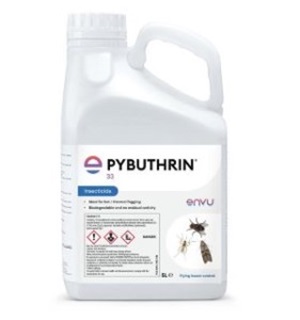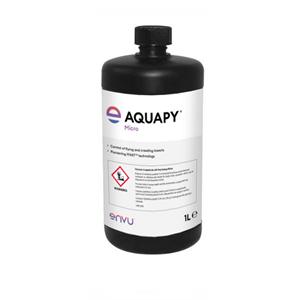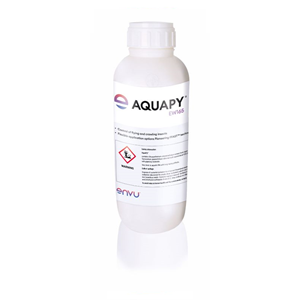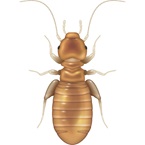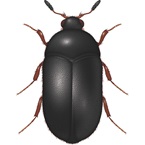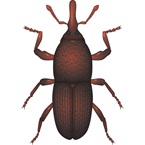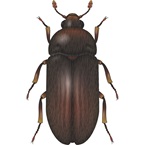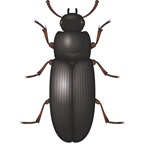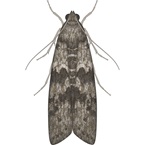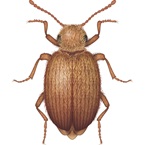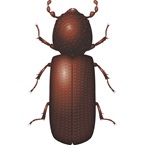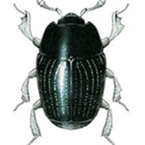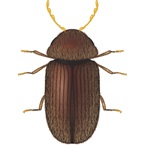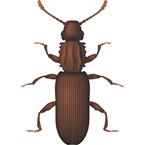Characteristics:
Two pairs of well developed membranous wings, with few cross veins; clothed with broad scales; generally suctorial mouthparts; metamorphosis complete with egg, larval, pupal and adult stages; larvae frequently have eight pairs of limbs.
Superfamily: Pyraloidea (family Pyralidae)
Superfamily: Tineoidea (families Oecophoridae, Tineidae)
Species characteristics:
Family: Pyralidae
Warehouse Moth (Cacao Moth, Tobacco Moth) (Ephestia elutella): 12mm wingspan; upper forewing: well defined, rather sinuate outer band on grey-buff background.
Tropical Warehouse Moth (Dried Currant Moth) (Ephestia cautella): 12-18mm wingspan; upper forewing: dull grey-brown; straight dark inner band has broad pale band along inner edge; outer band is obscure.
Mediterranean Flour Moth (Mill Moth, Flour Moth) (Ephestia kuehniella): 20-25mm wingspan; upper forewing: oblique irregular inner band spotted or streaked, lacking pale band along inner edge; outer band is obscure.
Indian Meal Moth (Dried Fruit Moth) (Plodia interpunctella): 10-15mm wingspan; upper forewing: inner third, pale yellowish buff; remainder of wing bronze-coloured.
Rice Moth (Corcyra cephalonica): 15-25mm wingspan; upper forewing: uniform pale buff-brown; no distinctive markings, although veins may be slightly darkened.
Family: Oecophoridae
Brown House Moth (Hofmannophila pseudospretella): 15-25mm wingspan; upper forewing: dark buff-brown with black-brown spots.
White-Shouldered House Moth (Endrosis sarcitrella): 15-25mm wingspan; upper forewing: buff-coloured and speckled brown; resembles Brown House Moth, but distinguished by white scales on head and thorax.
Family: Tineidae
Common Clothes Moth (Tineola bisselliella): 10-15mm wingspan; upper forewing: pale ochreous buff, unmarked.
Areas where found
Moths can be found in a variety of stored products. Some species are associated with goods of vegetable origin, to which they may be adapted with varying degrees of specificity, whilst others are associated with animal products - particularly textiles.
Warehouse Moth: Widely distributed throughout temperate regions. It is rarely imported except on products from other temperate areas.
Tropical Warehouse Moth: A tropical or subtropical species which is frequently found on imported cargoes.
Mediterranean Flour Moth: Originated in Central America but now cosmopolitan. It is a particular problem in provender mills, bakeries and occasionally even in catering premises. One generation is usually produced, but in warm conditions adults will be present throughout the year when there may be 4-6 generations.
Indian Meal Moth: A Cosmopolitan species which originated in South America. It will survive all year round in warm conditions.
Rice Moth: A tropical species often found in countries of northern Europe in imported foodstuffs. In these temperate areas it can survive all year round in heated stores but usually produces only one generation.
Brown House Moth / White-Shouldered House Moth: Both species are cosmopolitan and widespread on materials of animal or vegetable origin.
Common Clothes Moth: Common on animal products.
Importance as a pest
Moth larvae can cause considerable damage to stored goods by feeding or by contamination with their own products e.g. webbing and frass. Adult insects are not responsible for the damage as they either feed on liquid food and water or do not feed at all. The larval by-products, webbing and frass, are a particular problem. Webbing can entirely coat commodities and may be responsible for blocking machinery and ducts. The problem is exacerbated when webbing becomes mixed with frass, food and general debris.
Warehouse Moth: A major pest of warehouses and, more recently retail premises. This species will infest cereals, fruit, shelled nuts, cocoa beans, fish, spices and tobacco. In the case of tobacco, "sweet" varieties are preferred and entire interveinal leaf areas may be destroyed. Moth infestations are especially serious where wheat and flour are stored in bulk, although they seldom infest goods which are stored in silos.
Tropical Warehouse Moth: A particular problem in dried fruit and nuts, although this moth will attack cereals, oil seeds and chocolate products.
Mediterranean Flour Moth: Larval webbing can cause serious blockages in provender mills. The larvae eat holes in sifting silks and may also reach the mill's finished products.
Indian Meal Moth: Another species which is a particular problem of the fruit-drying industry. It will also attack cereals, oil seeds and shelled nuts. Larval webbing may occasionally reach problem proportions.
Rice Moth: This moth will attack grain (especially rice), oil seeds, cocoa beans, dried fruit, spices and beverages.
Brown House Moth / White-Shouldered House Moth: Both species attack a wide variety of materials including cereals, cereal products, textiles, leather and cork. The Brown House Moth tends to scavenge whilst the White-Shouldered House Moth is generally found infesting food.
Common Clothes Moth: Attacks animal products, for example wool, fur, skins and leather. Fibres are bitten off and the loose ends discarded, thus destroying much more commodity than is consumed.
Life-Cycle
Larval development is greatly influenced by the environmental conditions of temperature and food supply. The larvae themselves are unique and readily identifiable: well-developed head; clearly segmented body; three thoracic segments, each bearing a pair of five jointed legs; ten abdominal segments; numbers 3-6 bear false feet (prolegs), the tips of which are equipped with crochets; segment ten bears one pair of claspers.
Warehouse Moth: Within 4 days of emergence, the female produces 100-150 eggs which are laid in cracks and crevices. These hatch in 10-14 days to give larvae which are creamy white with dark spots on their sides. They penetrate food, covering it with webbing as they feed. In temperate climates larvae pass through 4-5 moults to attain full growth when they are 12mm long, whereupon they will leave the food and wander for 1-3 days, searching for a dark place in which to spin a silken cocoon. They may diapause in this state throughout the winter before pupating in April or May and emerging as adults in late spring. Under temperate conditions development takes from 82-206 days.
Tropical Warehouse Moth: Egg laying commences within 24 days of the adult's emergence and up to 350 eggs are laid during the first 4 days. These hatch 3-17 days later. The larvae are dirty white and may be tinged brown or have purple spots. At 25°C they will be fully grown in 25 days. The larvae do not diapause. Pupae develop in 12-17 days in the vicinity of food, and breeding is continuous. Where temperatures are low the moth overwinters as larvae.
Mediterranean Flour Moth: Mating takes place immediately after the adults emerge. Up to 350 eggs are laid and these may be stuck to various foods by a sticky secretion. The eggs hatch in 4-28 days to give white or pinkish larvae and spin silken tubes in which they live. After 3-5 moults the larvae are full grown and 15-19mm long. They then wander away from food and pupate for 7-16 days in the dark corners of buildings or machinery. In temperate climates these moths overwinter as larvae but, in contrast to other species, usually remain in the foodstuff.
Indian Meal Moth: Females produce up to 500 greyish-white eggs which hatch in 1-18 days depending upon conditions. The larvae migrate over the foodstuff, covering it with silk as they move. Their colour depends upon the type of food: they are generally dirty-white but may be tinged pinkish-brown or green. After 4-7 moults the larvae are full grown and have attained a length of 12mm. In this species food and environmental conditions have a dramatic influence on the larval phase, so that development may take 13-288 days. When mature the larvae leave the foodstuff and spin thick white cocoons, in which the 7mm long pupae develop. After a pupation period of 12-43 days, the adults emerge. These moths may overwinter as larvae which diapause in a silken cocoon.
Rice Moth: Up to 160 eggs are laid in or near the larval food. The larvae are dull white in colour with brown heads, and have long, fine hairs covering the body. They persist for 15-20 days under favourable conditions. Rice moth larvae produce large amounts of strong webbing and frass, before spinning a dense white cocoon in which to pupate. The pupal stage lasts 7-10 days.
Brown House Moth / White-Shouldered House Moth: These species have similar life-cycles and mixed infestations frequently occur. The Brown House Moth lays up to 650 eggs, preferring rough open surfaces, whilst those of the White-Shouldered House Moth are sticky and laid in crevices. Brown House Moth larvae are glossy white and reach a length of 16mm. Larvae generally diapause for varying lengths of time, depending upon the conditions under which they have developed. Those of the White-Shouldered House Moth are dull white and rarely exceed 14mm in length. Both species burrow into the food, forming a silk tunnel. Pupal cocoons are rough and incorporate foodstuff and debris.
Common Clothes Moth: Eggs are laid amongst fibres or scattered at random. Each female lays up to 160 eggs during a period of 2-3 weeks. During the summer these hatch in 4-10 days to give an active, white translucent larva. This grows up to 10mm in length and the head becomes darker in colour. Feeding tunnels may be constructed from silk and there are at least 5 moults. Larvae construct a tough cocoon in which they moult to produce a pupa up to 7mm long. The full cycle takes between 88-254 days, depending upon conditions.
Control
The method and timing of control measures against moths, depends upon the species involved. The larvae are frequently difficult to reach because they are concealed in foodstuffs or the fabric of buildings and may be obvious only when they migrate.
Assessment of infestations
Adhesive traps are used for trapping stored product moths. Attractant capsules containing a pheromone are attached to a sticky surface on which the moths are caught and which is partially protected from the environment. The trap is then suspended ca 2-3m above the floor. They perform best in locations which are not dusty. Alternatively funnel traps may be used. These are usually constructed of plastic and incorporate a funnel system leading to a retaining chamber in which moths are trapped and killed using a toxicant strip, water or detergent. They incorporate a pheromone lure and are particularly useful in dusty locations. The simplest traps are a dish of water containing a little detergent. Whatever system is employed adequate records must be kept.
a) Hygiene/management
This is important in order to avoid conditions suitable for the development of moth infestations. Warehouses should be constructed so as to ensure maintenance of correct storage conditions and allow easy cleaning. Cracks and crevices which might serve as harbourages should be kept to a minimum. Stacks of commodities should be neatly arranged above the floor on pallets, with a gap between stacks to allow for ventilation, regular inspection, cleaning and treatment with insecticides if necessary. Good packaging is particularly important to prevent entry of larvae.
Spillages should be removed promptly, and infested goods dealt with immediately either by fumigation or destruction. Uncontaminated products should not be stored in the vicinity of infested materials.
In the case of the house and clothes moths, fabrics should be regularly inspected and cleaned, and alternative breeding sites, for example birds' nests, removed if possible. It should be remembered that soiled fabrics make a more acceptable diet to these insects than clean ones.
b) Insecticidal control
In order to obtain the best results, insecticidal control measures should be integrated with good hygiene.

